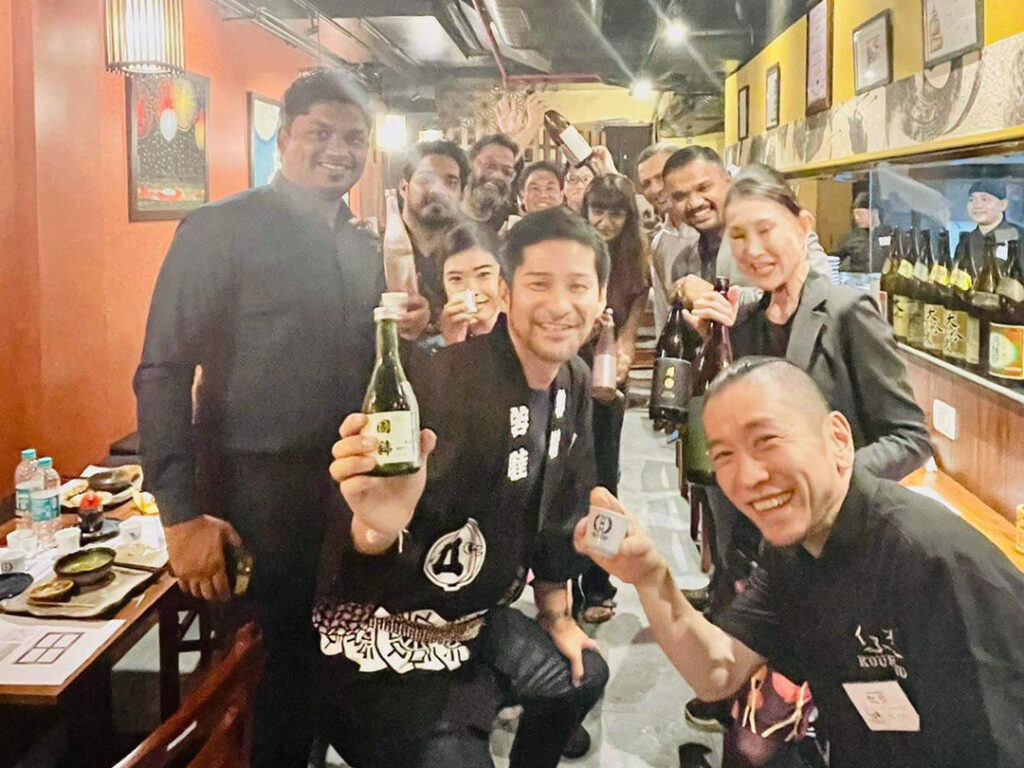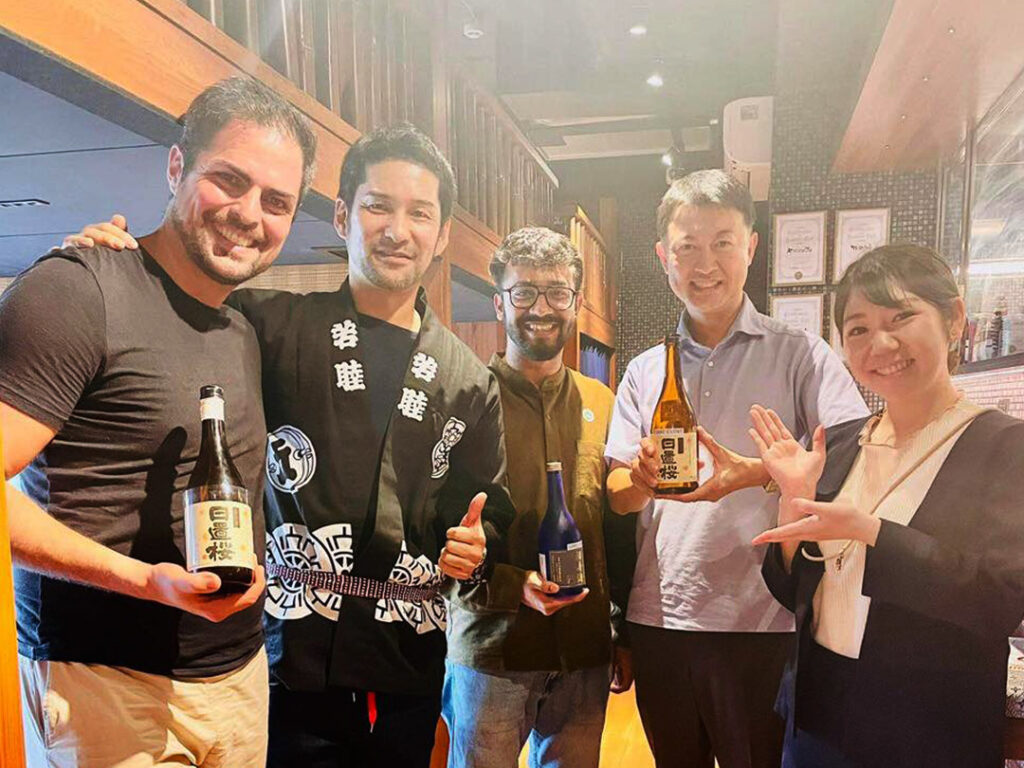Hello, this is Kojiro Honda.
The other day, we had an opportunity to let people in India know about Japanese food culture.
We held a restaurant seminar business meeting at Kuuraku on October 10 and 11. This was a part of “Japanese liquor import coordinator in India” appointed by the National Tax Agency.
Many people in India have never had sake
Since the purpose of the event was to let people know about sake, we invited a sake taster who is doing business in India and asked him to give a lecture while enjoying food pairing. We had many participants, including people from restaurants, sake retailers, and people from malls.

Two-thirds of the participants had never had sake before, and we were looking forward to seeing what kind of reactions we would get. To begin with, sake is a luxury item in India. It is because it is not that widely available in the market.
The program was very well received by local people, with approximately 90% of participants in both Bangalore and Mumbai rating the program as “very satisfactory”.
Specifically
‘I was able to deepen my taste and knowledge of sake, starting with the wonderful sake and food pairings.’
The hospitality of the entire staff was excellent.
We received many positive comments such as, “The hospitality of all the staff was excellent.
We got a good response from this event and would like to try to organize a shop-led event in the future.
What is the annual export value of sake to India?
I had the opportunity to ask the National Tax Agency about the annual export of sake from Japan to India, and the numbers were astonishing.
How much do you think it is?
The correct answer is 46 million yen.
These are numbers for all of India, for the last year. I was surprised, “Oh, that’s just it? I was surprised. It is surprisingly small, don’t you think?
Although not widely known, the value of Japanese liquor exports to India is as follows.
■Exports of Japanese Alcoholic Beverages to India(Millions of yen)
| whisky | gin and vodka | refined sake | total amount | |
| 2022 | 420 | 131 | 46 | 612 |
| 2023 (Jan-Jun) | 250 | 161 | 15 | 545 |
In 2021, annual sake exports to China are estimated to be 10.2 billion yen, so the value of sake exports is currently quite small.
(Source: Trade Statistics, Ministry of Finance)
There are two main logical reasons for the low export volume.
1、Sake label registration rules are complex.
First, the rules for sake label registration are complex and cumbersome, requiring registration by state.
Recently, there was a period of time when imports were temporarily halted by India’s sanitation authorities (FSAAI) due to the presence of ingredients in sake that are not present in India.
Due to persistent negotiations from Japan, we are now able to clear the Labo test if we do it. The Embassy’s official in charge is negotiating with us so that the Labo test will no longer be necessary in the future.
2、Lack of inexpensive cold supply chain
Another is that the cold supply chain, such as refrigerated refrigerated vehicles and warehouses, has not yet been established throughout India.
At the moment, the number is very small, which means that the cost of distributing the product is high.
If these two issues are solved one by one, and a proper PR strategy that is mutually beneficial to both parties is developed and implemented, the value of exports will steadily increase.
We were also given annual export amounts to Australia, Italy, the U.S., and other countries, so we made various hypotheses based on these figures to determine how much we could increase our annual export amount. Our goal is to increase the amount by 50 times to approximately 2.3 billion yen in five years. I believe this is not an impossible figure.
What kind of sake is preferred in India?
Men living in India tend to drink whiskey, gin, rum, and other relatively high alcohol content, while women prefer wine and cocktails. And now, sake is booming in India. The event we held this time also included the following words
Sake is starting to be popular in India.
“I want to learn more about sake so that I don’t miss out on the trend.
I myself have been involved in the sake industry in India.
I myself am aware of the fact that sake is becoming popular in India. For example, when I am serving customers at a store, I hear customers asking me, “Do you have a different brand?
“Do you have a different brand?
I have also seen an increase in the number of customers asking me, “Do you have a different brand of sake?
Also, in Chennai, we don’t have a single bottle of sake yet in the restaurants we operate there.
“Do you have any sake in this restaurant?”
I am asked. When I see more cases like this, I realize that there is still a demand for sake.
Sake is getting a lot of attention
At the event, we talked about why sake tastes different.
Starting with water and rice, there are sake breweries all over the country. We talked about the differences in rice polishing and raw materials used to make sake, and how each sake brewery produces its own unique sake. I also told them about the different types of sake, such as Kaoru-shu and Soshu. I was impressed by the seriousness with which everyone listened to me.

As for specific brands, “Nanbu Bijin” and “Hanaki Sakura” were particularly popular, with several participants saying they were attracted by the unique flavor of each.
Of course, we also had participants who are familiar with sake. We received some comments from them.
For example, what kind of sake would go well with biryani?
We received many specific questions such as, “For example, what kind of sake would go well with biryani?
In response to these questions, I would like to make it possible for people to choose sake in the same way they would choose wine: “Today we are having lamb, so this sake goes well with that,” or “This sake goes well with fish. In the future, we would like to create opportunities to suggest sake to go with the familiar Indian cuisine.
Here are some other sake products that may become popular in India.
1. Shochu: Given India’s climate and food pairings, it is easily accepted.
2. Shochu and Whiskey: There is room for growth in that they do not require a cold chain for distribution. It goes well with strong-flavored Indian food.
Awamori: Okinawa’s climate is similar to that of southern India, and the alcohol content of awamori is similar to that of Indian liquors. Awamori goes well with strong-flavored Indian cuisine.
For those who are thinking of opening restaurants in India, the key point may be how to introduce Japanese sake to Indian people.
By holding such events in the future, we will accelerate cultural exchange between Japan and India through the spread of sake PR.
If you are interested in promoting sake in India, we would like to hear from you.
If you have any other questions or concerns about business in India, please feel free to contact us.


